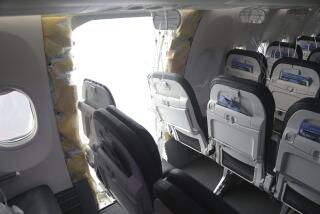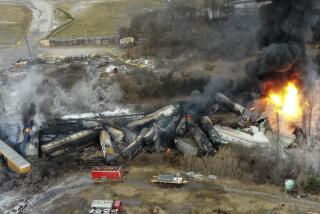FAA Aim: Better Transocean Navigation
- Share via
WASHINGTON — The Federal Aviation Administration, spurred by a government report on a near-collision, vowed Friday to improve navigation procedures on long flights across the Atlantic and Pacific oceans.
The agency’s statement came a day after investigators disclosed that an off-course Delta Air Lines L-1011 came within about 30 feet of another jetliner over the North Atlantic in July--much closer than previously thought.
All U.S. airlines flying transpacific and transatlantic routes will soon be sent a bulletin reviewing navigation procedures for flying outside of radar control, the FAA announced.
That move came at the recommendation of the National Transportation Safety Board, which investigated the July 8 near-collision between the Delta jet and a Continental Airlines Boeing 747.
Reconstruction of Incident
Anthony Broderick, FAA associate administrator for aviation standards, said he expects the navigation bulletin to go out to carriers “in a matter of days, not weeks.” It will include a reconstruction of the Delta incident, with detailed notations about navigation rules that apply in such a situation.
Broderick said the FAA also is making preparations for a meeting in the next 30 to 60 days of industry navigation specialists, followed by a gathering of operations supervisors at major carriers with transoceanic flights. Those meetings could result in the carriers’ agreeing to changes in navigation procedures, he said.
“I don’t think we need a formal rule change to have mandatory procedural changes. We already require airlines to have FAA approval of their long-range navigation program, so if we change the ground rules, we can work out changes,” he said.
If the agency decides to seek formal regulatory changes regarding navigation, “we would probably have much of the material drafted and out for public comment this year,” Broderick said.
Review of Pilot Training
Changes in navigation procedures also could come out of a broad-ranging review of pilot training launched recently by FAA Administrator T. Allan McArtor, he added.
In the July incident, the Delta crew did not have the oceanic charts needed to verify that the plane’s computerized navigation system was in fact directing the aircraft on course, the safety board said Thursday. A Delta spokesman disputed that statement.
The board also said the cockpit crew made no attempt to verify its location, relying instead on the automated system.
The FAA does not specifically require such verification, although it advised airlines seven years ago that periodic checks would be prudent on flights over the ocean where no ground-based radar is tracking planes.
The safety board suggested that the FAA call for pilots on transoceanic flights to verify their location, independent of the automated system, at least three times during a flight.
More to Read
Sign up for Essential California
The most important California stories and recommendations in your inbox every morning.
You may occasionally receive promotional content from the Los Angeles Times.












